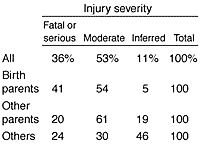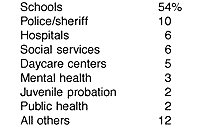|
The number of children identified as abused or neglected almost doubled between 1986 and 1993 An estimated 2,815,600 children were identified as maltreated in 1993 The third National Incidence Study of Child Abuse and Neglect (NIS-3) reports information on children harmed or believed to be harmed by maltreatment in 1993. Child maltreatment includes physical, sexual, and emotional abuse, as well as physical, emotional, and educational neglect by a caretaker. Victims of maltreatment may die as the result of abuse or neglect or may experience serious or moderate harm. A child may also be in danger of harm as the result of maltreatment, or harm may be inferred when maltreatment is sufficiently severe. NIS-3 includes maltreatment reported to researchers not only by child protective services agencies, but by other investigatory agencies (e.g., police, courts, public health departments) and community institutions (e.g., hospitals, schools, day care centers, and social service agencies). It does not include cases known only to family members or neighbors.
Most maltreated children were neglected in 1993 NIS-3 counts each incident of abuse or neglect that occurs. A single child may experience many types of abuse or neglect. In 1993, 70% of maltreated children were victims of neglect and 43% were victims of abuse. More specifically:
Types of maltreatment are related to the characteristics of the child The incidence of maltreatment varied by sex and age but not by race or ethnicity:
More maltreatment was reported among lower income families in 1993 Children from families with an annual income of less than $15,000 were found to have substantially more maltreatment of all types than children from families of greater incomes. The abuse rate in these lowest income families was two times the rate of families with higher incomes. Similarly, the neglect rate was more than three times higher in these families. Compared with those from families with incomes above $15,000, children in lower income families had a higher injury rate in every injury category except fatalities. Children of single parents were at higher risk of maltreatment in 1993 The risk of maltreatment was twice as great for children of single parents than children living with both parents. Compared with children living with both parents, children living with single parents were twice as likely to be neglected and were marginally more likely to be abused. Children living with a single parent of either sex experienced a higher incidence of physical and educational neglect than those living with both parents and were marginally more likely to experience emotional neglect. Children from single parent homes were at higher risk of injury and of being endangered by maltreatment than those living with both parents in 1993. Maltreatment is related to family size
The majority of maltreated children were victimized by their birth parents Birth parents accounted for the largest proportion of maltreatment victimizations in 1993 (78%), followed by other types of parents (14%) and other perpetrators (9%). Children victimized by their birth parents were twice as likely to experience neglect than abuse in 1993. More specifically, among children victimized by their birth parents:
In contrast to children victimized by their birth parents, those maltreated by other types of parents were almost twice as likely to be abused than neglected. For example:
Children maltreated by birth parents were twice as likely to suffer a fatal or serious injury than those maltreated by others  Most maltreatment cases are recognized by schools Because of the large volume of children attending schools, more maltreated children were identified by schools in 1993 than by other community agencies and institutions combined:  One third of alleged child maltreatment cases were investigated by child protective services in 1993 Child protective service agencies investigated 33% of the cases known to community agencies and institutions in 1993. The remaining cases were either not reported or reported but not investigated by child protective services. The highest rates of investigations occurred among cases recognized by police and sheriff departments (52%), hospitals (46%), and mental health agencies (42%). In contrast, the lowest rates of investigations occurred among cases recognized by daycare centers (3%) and public health agencies (4%).
Investigations were more likely among children recognized as abused than neglected in 1993 Children alleged to be physically or sexually abused were investigated by child protective services more frequently than other maltreated children.
Child protective services agencies received 2 million reports of child maltreatment in 1994 NCANDS monitors the caseloads of child protective services The National Center on Child Abuse and Neglect (NCCAN) annually collects child maltreatment data from child protective service agencies. The National Child Abuse and Neglect Data System (NCANDS) employs both a summary and case level approach to data collection. Summary data provide national information on a number of key indicators of child abuse and neglect cases in 1994. Case-level data provide descriptive information on cases referred to child protective service agencies in 1993. About 1.6 million child abuse and neglect investigations were conducted in 1994 Child protective service agencies conducted investigations on 82% of the estimated 2 million reports of child abuse and neglect in 1994. In 37% of these investigations the allegation was either substantiated (i.e., the allegation of maltreatment or risk of maltreatment was supported or founded) or indicated (i.e., the allegation could not be substantiated, but there was reason to suspect the child was maltreated or was at risk of maltreatment). More than half (56%) of all investigations were not substantiated or indicated. The remaining 7% were closed without a finding or were found to be intentionally false reports.
Information contained in reports varied by the source of the report Ten States provided detailed data on the source of reports received by child protective service agencies during 1993. This information shows that:
Detailed information from States reporting case-level data on victims of substantiated or indicated maltreatment in 1993 found the following:
Over 1,000 children died as a result of maltreatment in 1994 The 1994 national summary data on substantiated or indicated maltreatment found the following:
Most perpetrators were female and under age 40 in 1993
The 1993 case-level data on perpetrators of substantiated or indicated maltreatment were provided by seven States. This information showed that:
|
| Previous | Contents | Next |
|
Juvenile Offenders and Victims: 1997 Update on Violence |